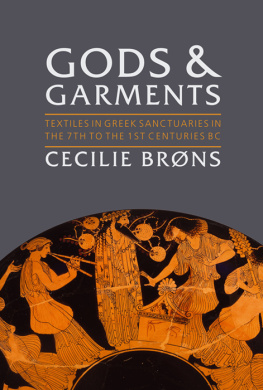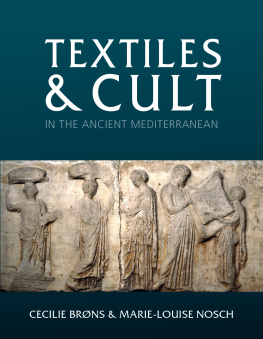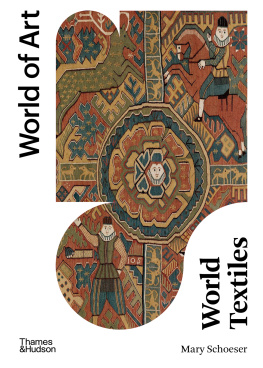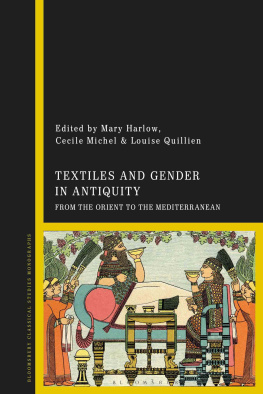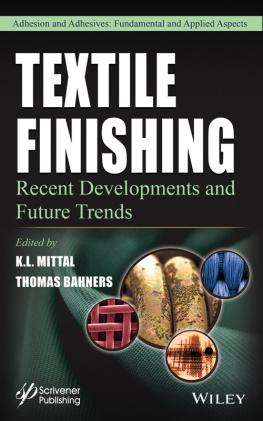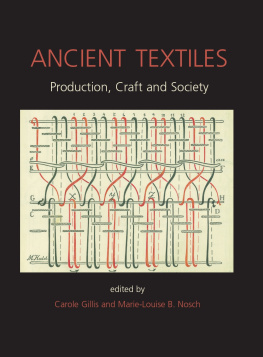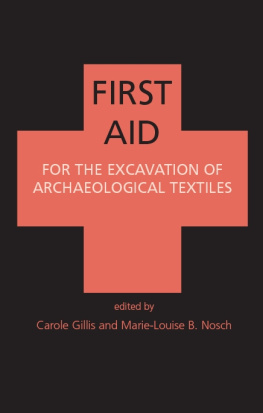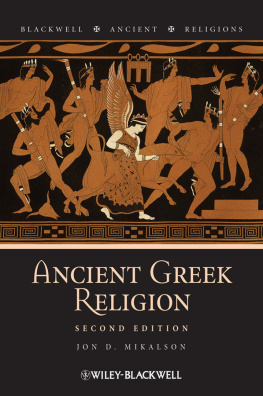Published in the United Kingdom in 2016 by
OXBOW BOOKS
The Old Music Hall, 106108 Cowley Road, Oxford OX4 1JE
and in the United States by
OXBOW BOOKS
1950 Lawrence Road, Havertown, PA 19083, USA
Oxbow Books and the individual contributors 2016
Hardback edition: ISBN 978-1-78570-355-3
Digital Edition: ISBN 978-1-78570-356-0 (epub)
A CIP record for this book is available from the British Library
Library of Congress Cataloging-in-Publication Data
Names: Brns, Cecilie, author.
Title: Gods and garments : textiles in Greek sanctuaries in the 7th-1st centuries bc / by Cecilie Brns.
Other titles: Gods and garments (2017)
Description: Philadelphia : Oxbow Books, 2017. | Series: Ancient textiles series ; 28 | Based on the authors thesis (University of Copenhagen). | Includes bibliographical references.
Identifiers: LCCN 2016044906 (print) | LCCN 2016047159 (ebook) | ISBN 9781785703553 (hardback) | ISBN 9781785703560 (epub) | ISBN 9781785703577 (mobi) | ISBN 9781785703584 (pdf)
Subjects: LCSH: Textile fabrics, AncientGreeceReligious aspects. | Clothing and dressGreeceReligious aspects. | GreeceReligion.
Classification: LCC BL65.C64 B76 2017 (print) | LCC BL65.C64 (ebook) | DDC 292.3dc23
LC record available at https://lccn.loc.gov/2016044906
All rights reserved. No part of this book may be reproduced or transmitted in any form or by any means, electronic or mechanical including photocopying, recording or by any information storage and retrieval system, without permission from the publisher in writing.
Printed in to be inserted
Typeset in India by Lapiz Digital Services, Chennai
For a complete list of Oxbow titles, please contact:
UNITED KINGDOM
Oxbow Books
Telephone (01865) 241249, Fax (01865) 794449
Email: oxbow@oxbowbooks.com
www.oxbowbooks.com
UNITED STATES OF AMERICA
Oxbow Books
Telephone (800) 791-9354, Fax (610) 853-9146
Email: queries@casemateacademic.com
www.casemateacademic.com/oxbow
Oxbow Books is part of the Casemate Group
Front cover: to be updated in due course
Back cover: to be updated in due course
For my family
Contents
Acknowledgements
The current study has been carried out as a collaboration project between The Danish National Research Foundations Centre for Textile Research (CTR) and the Department of Ancient Cultures of Denmark and the Mediterranean in the National Museum of Denmark. It was made possible by generous grants from these institutions as well as The Danish Ministry of Culture, for which I am very grateful.
I am grateful to more people than I can possibly name here, but some deserve special mention. First of all I am deeply grateful to Marie-Louise Bech Nosch, who oversaw this project from its inception as a doctoral thesis to its final publication, for all her invaluable guidance and support. This project has greatly benefited from her insightful comments, suggestions, and intellectual generosity. My deepest gratitude is also due to Bodil Bundgaard-Rasmussen and Lone Wriedt-Srensen for all their kind support and advice. Furthermore, Mary Harlow, Tyler Jo Smith, and Jane Fejfer have all given invaluable advice on my dissertation and its revision into this publication.
I have had the great privilege of being affiliated with CTR, a research centre including the utmost experts in the field of textile research. I am grateful to the TEMA-group (Textile Economies in the Mediterranean Area) in particular for being so generous with their immense knowledge and for all our interesting discussions: it is definitely an inspirational environment that makes you grow as an academic scholar. I am especially indebted to Peder Flemestad for all his patient and generous assistance and guidance in epigraphic and literary matters. Without him, I would not have been able to perform this study. Warm thanks also to Giovanni Fanfani for help in various matters.
It has been an equally great privilege to work at the department of ancient cultures of Denmark and the Mediterranean at the National Museum of Denmark. Here I have been blessed with wonderful colleagues, who have always been generous with their immense knowledge and support and not least able to put a smile on my face.
I also wish to thank The Danish Institute at Athens, which provided me with the perfect place to stay in order to perform my research. Special thanks are due to Rune Frederiksen and Sren Handberg for kindly arranging my guest lecture at the Institute, as well as the staff at the Nordic Library in Athens for their kind assistance. My gratitude also goes out to the MacDonald Institute at the University of Cambridge for granting my stay as a guest scholar, especially to Margarita Gleba for arranging my visit as well as welcoming me and arranging my lecture at the university.
My warmest thanks are also due to Mark Nugent who did a wonderful job on editing my book for publication. My work has indeed benefited greately from his expertise. I am also very grateful for all the help and assistance I have gotten from my friend and colleague Signe Skriver Hedegaard.
I would like to thank Jan Kindberg Jacobsen, Rune Frederiksen, Sren Handberg, Bjrn Lovn, and Kalliopi Sarri for their assistance in obtaining images for the book as well as Helle Horsns for providing excellent images from the Royal Collection of Coins and Medals in the National Museum of Denmark. Furthermore, I am grateful for the images of the artefacts in the Staatliche Museum zu Berlin, most kindly provided by Johannes Laurentius.
Great thanks are also due to Morten Svendsen and Werkstette for the excellent and professional work on the images for this book.
I am very grateful for the generous funding provided by Her Majesty Queen Margrethe and Prince Henriks Foundation for the publication of this book.
I am also deeply indebted to my wonderful friends Luise rsted Brandt, Nora Petersen, and Dea Forchhammer for their friendship, eternal support, and not least their invaluable pep-talks. Finally, I wish to thank my family, especially my parents and my beloved sister Rebecca, for all their love and unfailing support I could not have done this without you.
Abbreviations
AJA : American Journal of Archaeology
AM : Mitteilungen des Deutschen Archologischen Instituts, Athenische Abteilung
ArchDelt : Archaiologikon Deltion
BCH : Bulletin de correspondance hllenique
BABesch : Bulletin antieke Beschaving
BICS : Bulletin of the Institute of Classical Studies
BMC 4 : Gardner, P., British Museum Coins. Seleucid Kings of Syria , London 1878
BMC 8 : Head, B. V., British Museum Coins. Central Greece , London 1884
BMC 16 : Head, B. V., British Museum Coins. Ionia , London 1892
BMC 13 : Head, B. V., British Museum Coins. Caria and the Islands , London 1960
BMC 17 : Wroth, W. W., British Museum Coins. Troas, Aeolis and Le s bos , London 1894
BMC 19 : Hill, G. F., British Museum Coins . Lycia, Pamphylia and Pisidia , London 1897
BMC 21 : Hill, G. F., British Museum Coins. Lycaonia, Isauria and Cilicia , London 1960
BSA : Annual of the British School at Athens
CAJ : Cambridge Archaeological Journal
ClAnt : Classical Antiquity
CQ : Classical Quarterly
GRBS : Greek, Roman & Byzantine Studies
HarvTheolR : Harvard Theological Review
HSCP : Harvard Studies in Classical Philology
ID : Inscriptions de Dlos , Paris 19261972
IG : Inscriptiones Graecae , Berlin 1873
JdI : Jahrbuch des Deutschen Archologischen Instituts

